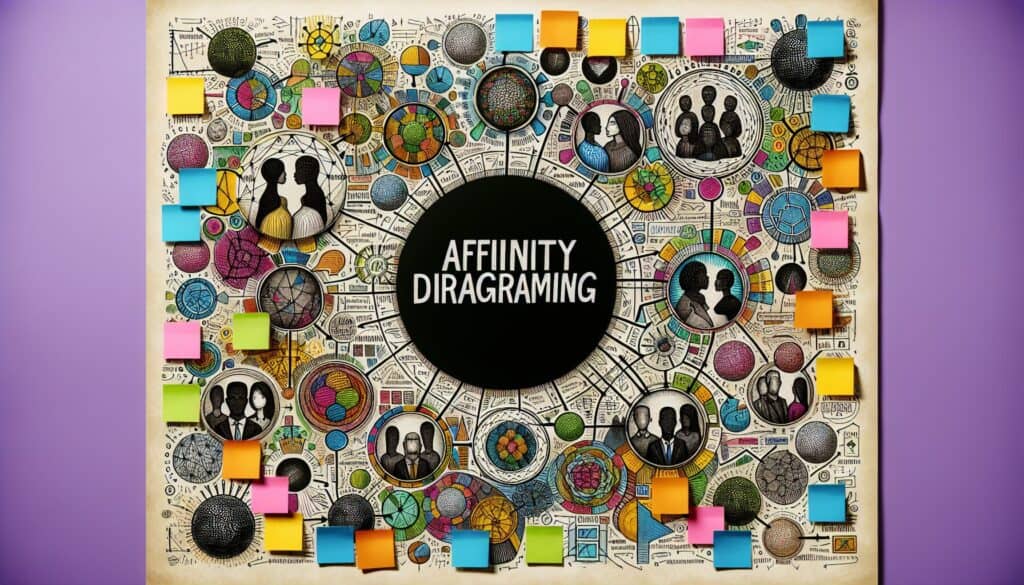A technique used to organize a large number of ideas, issues, or pieces of information into related groups or themes based on their natural relationships. Also known as the KJ Method.
- 方法: 人体工程学
Affinity Diagramming (KJ Method)

Affinity Diagramming (KJ Method)
- 集思广益, 变更管理, 持续改进, 设计思维, 构思, 创新, 解决问题的技巧, 质量管理, 以使用者為中心的設計
目标
如何使用
- Ideas (often written on sticky notes) are generated by a group. Participants then silently group related ideas together. Once grouped, the team discusses the groupings and creates header cards or labels that capture the essence of each theme.
优点
- Helps to make sense of large amounts of qualitative data or brainstormed ideas; Encourages participation and builds consensus; Reveals underlying themes and patterns; Relatively simple and quick to implement.
缺点
- Can be time-consuming with very large datasets; Grouping can be subjective and influenced by dominant personalities if not well-facilitated; The resulting themes may require further analysis or prioritization.
类别
- 客户与营销, 构思, 解决问题, 产品设计, 质量
最适合:
- Organizing and synthesizing large amounts of qualitative data, such as brainstormed ideas, user feedback, or research notes, to identify key themes and insights.
Affinity Diagramming, also known as the KJ Method, serves as a powerful tool in diverse sectors such as product development, user experience research, and strategic planning, particularly during the ideation and concept development phases of projects. This methodology is often initiated by cross-functional teams, including designers, engineers, product managers, and market researchers, who come together to gather qualitative data, which can encompass user feedback, insights from customer interviews, or brainstorming sessions. As team members silently sort ideas written on sticky notes, this organization encourages individual reflection while promoting engagement among participants, leading to a more thorough consideration of various perspectives. After the grouping process, the discussion phase allows teams to collaboratively label these clusters, which supports consensus building around key themes that may influence subsequent design choices or strategic directions. Affinity Diagramming is frequently utilized in industries such as technology, healthcare, and consumer goods, where understanding user needs and preferences is imperative to create effective solutions. Practitioners appreciate its simplicity and speed, as it can be completed within a few hours, making it adaptable for rapidly evolving project timelines while ensuring that team voices are heard equally in the development process. This method not only organizes ideas but also reveals patterns that might otherwise go unnoticed, providing a structured framework for driving innovation and aligning team objectives with user-centric insights.
该方法的关键步骤
- Generate ideas on sticky notes individually.
- Silently arrange related ideas into groups on a shared surface.
- Review groups and discuss relationships between ideas with the team.
- Create header cards or labels for each group that summarize the main theme.
- Refine groupings and headers based on team discussions.
- Identify and prioritize key themes for further exploration or action.
专业提示
- Encourage participants to use diverse perspectives by inviting individuals from different departments or backgrounds to enhance the variety of ideas generated.
- Utilize color-coded sticky notes to represent different categories or themes, facilitating quicker visual identification during the grouping process.
- Incorporate a follow-up phase for synthesizing the grouped ideas into actionable strategies, ensuring that the themes lead to concrete outputs beyond the initial session.
历史背景
1949
1950
1950
1960
1960
1960
1960
1940
1950
1950
1958
1960
1960
1960
1960
(如果日期不详或不相关,例如 "流体力学",则对其显著出现的时间作了四舍五入的估计)。















相关文章
METS 卡路里计算器
元分析
信息映射
心理模型图
可接受的最大推力和拉力
物料需求计划(MRP)